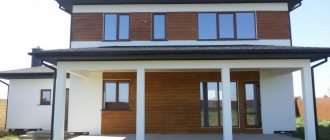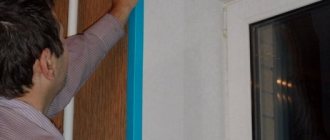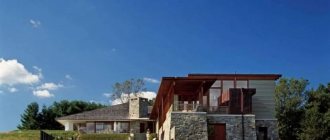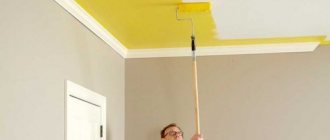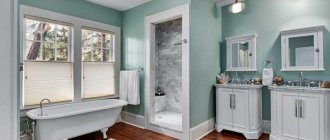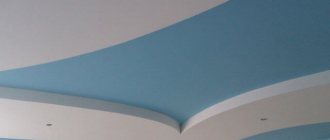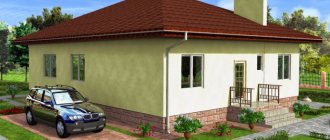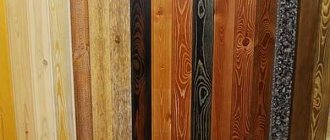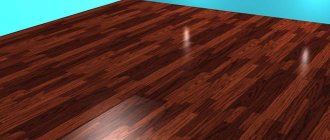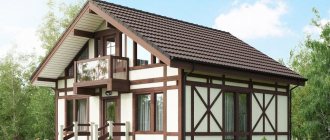Despite the modern abundance of various building materials, wooden houses remain traditional in almost all regions of Russia. From time immemorial, their log houses were erected in both urban and rural areas. Nowadays, the possibilities of using wood have expanded significantly - today, processed timber is widely used for the construction of residential buildings, frame structures made of lumber and plywood or chipboard (OSB) are used.
Painting a wooden house inside
Every home owner, when choosing natural wood or materials based on it to build a house, wants it to retain its original qualities for as long as possible. Therefore, painting a wooden house inside, as well as outside, is a mandatory process to create conditions for long-term operation of such buildings. In addition, this significantly expands the horizons in the possibilities of both external and interior design.
Why do you need to paint the inside of a house and what paints are used?
People have been building wooden houses for centuries. Warm in winter and cool in summer, such a house became a real family nest. However, wood is a soft natural material - wooden surfaces are defenseless against dampness, can dry out, and are susceptible to fungi and mold. Painting wooden walls inside the house solves all these possible problems.
For example, in a bathroom, properly painted walls will be protected from moisture on the wood and the formation of fungus Source lineyka.net
To avoid problems, you need to know what wood processing compounds exist and what they are needed for:
- various types of primer, penetrating inside the wood, create a protective layer, increase the adhesion of the paint to the surface, and painting the primed surface becomes much easier;
- antiseptic compounds protect wooden surfaces from mold and mildew;
- wood stains are special compounds that give wood different shades and protect it from adverse external factors;
- paints create a durable surface layer, the difference in shades and structures allows the paint to be used in rooms with different purposes;
- varnish is a colorless or lightly tinted durable coating that gives wood shine and protection, significantly improves the appearance, and increases the durability of wooden products.
The compositions can be combined to create a durable and beautiful coating. For example, walls are painted after preliminary priming of the surfaces, and varnish is often applied over stain.
Reasons for the need to stain wood
Why is it generally necessary to treat wood with various paints and varnishes? It would seem that the natural texture of wood is attractive in itself, and in most cases there is no particular need to embellish it? And all this is due to the fact that impregnation and painting of wood is capable of preserving its physical and aesthetic properties for the longest possible time, such as integrity, strength, warmth, environmental friendliness of the material and the beauty of its textured pattern.
As you know, the first enemy of wood is moisture, which, when it penetrates the structure of the material, has a destructive effect on its fibers. As a result, they swell and deform, losing elasticity and strength. Inside a house with damp walls, various fumes that are unpleasant for the senses inevitably dominate, which easily permeate the structure of the wood. In addition, dampness always “kicks off” the biological decomposition of wood, causing the appearance of mold and blue stains, which, in turn, in addition to creating an unhealthy atmosphere in the premises, also weaken the strength of the building material.
Paint and varnish products, as well as special protective compounds, are primarily designed to protect wood from negative external influences and preserve its structure from destruction. And, of course, the task is always to preserve the aesthetic texture of the wood unchanged or to decorate it in accordance with the intended interior design.
Which paint to choose
Depending on the composition, paints have different properties; interior painting of a room should be done with high-quality compounds that are safe for health, especially if children will live in the house.
Choosing what to paint the inside of a wooden house and deciding on a specific paint color for any interior will not be difficult, the main thing is to pay attention to its safe properties Source dizainkuhnibest.ru
See also: Catalog of companies that specialize in insulation and finishing of houses.
If you are going to paint windows, doors or heating radiators, please note that the paint should not change color under the influence of heat and sunlight, and these surfaces must be washed frequently. Paint for the interior decoration of a wooden house must be abrasion-resistant and should not be washed off with water.
- Oil paints give a shiny, glossy surface, are easy to clean, but do not allow moisture to pass through, take a long time to dry and have an unpleasant odor that disappears in several days.
- Acrylic paints adhere perfectly, have virtually no odor, remain bright for a long time, and can be washed.
- Alkyd paints and enamels form a stable glossy finish, are waterproof, durable and quite cheap. When painting, it is necessary to use a respirator, since this type of paint has an unpleasant odor.
- Water-dispersion paints are safe, do not have an unpleasant odor, are durable, and do not fade. The disadvantage may be that it is quite difficult to wash a surface coated with water-based paint using detergents.
Water-dispersed paints are chosen for rooms where heavy pollution is not expected Source postroikado.ru
- Silicone paints
are suitable for all rooms, do not fade, do not crack, have excellent vapor permeability, and are easy to clean. The only drawback of this type of paint is the high price.
The choice of color depends entirely on your preferences. Dark colors visually make the room smaller, while light colors make it larger. The desired shade, which is not commercially available, can be obtained using a tint. It is necessary to tint the entire volume of paint at once, otherwise it may turn out to be different shades.
Application area
All three of these products create a matte surface when painted. But due to the composition of the included components, they have different areas of application. So:
- Solid oil 245, which contains a mixture of natural resins, oils and waxes, is used to coat all types of wooden surfaces: ceilings, walls, window sills, furniture, interior elements, toys and even floors in any room.
- Glaze with beeswax 470, which contains natural oils, resins, beeswax and water as a diluent, is suitable only for walls, ceilings and wooden decorative elements.
- Wax glaze 450, consisting of a mixture of waxes and water, without the addition of oils, is suitable for painting walls and ceilings in dry rooms that do not require frequent washing and do not have contact with moisture.
What does the label tell you?
When choosing paint, pay attention to the information on the can. The manufacturer must indicate:
- What kind of work, internal or external, is the product intended for?
- In what rooms can it be used? For example, paint for children's rooms is absolutely not suitable for the bathroom.
- Covering power. The higher this indicator, the lower the paint consumption per m².
- At what temperature is this paint used?
- Spreadability. The paint should not be too thick; after application, the painted surface remains smooth, without grooves or drops.
- The can indicates how much surface area can be painted.
Approximate paint consumption per 1 m² Source yandex.ru
After carefully studying this information and consulting with the seller, you will definitely choose the best option for your home.
Material calculation
Before purchasing paints and varnishes, you need to calculate the required volume. When making calculations, you can rely on the data on the label, which indicates the consumption of the product. Also, when spending, you should take into account such factors as:
- Age of wood - the older the wood, the more it absorbs paint;
- Quality of surface preparation - the rougher the sanding, the more paint will be required
- Tools used for application. For example, using a brush will result in lower product consumption than when applying with a roller or spray.
When making calculations, it is better to consult with a specialist and take materials with a small margin. For example, the calculation of paint for walls made of logs should be made with a margin of 30% due to the round shape of the log.
The cost of the finished surface, painted in two layers, is: for 245 Hard - 140 rubles. per sq.m., 470 Lazuli with beeswax – 103 rub. per sq.m., and for 450 Wax-lazuli - 88 rubles. per sq.m.
All oils and glazes are tinted in a wide range of colors.
When choosing paint for interior painting of a wooden house, give preference to high-quality materials that are safe for your health and your children.
Tools needed for painting
In addition to paint, workers will need the following tools:
- rubber gloves, possibly respirators and hats;
- brushes, rollers, paint trays;
- masking tape to avoid staining surfaces that will not be painted;
- sprayer, with its help painting is carried out much faster;
- a wet rag and a bucket of water to immediately clean up any spills.
There may be several brushes; if you use oil paint or alkyd enamel, stock up on solvent; you won’t be able to remove drops from these paints with water.
Preparing the surface for painting
Painting the walls in the house, the stages that precede it and, most importantly, painting, must be done with high quality.
Before painting, the surface is cleaned of old paint, dust, and greasy contaminants. The washed surface is left to dry. The cracks are sealed using acrylic sealant. This will protect against temperature changes and keep you warm.
Alignment
To obtain a smooth matte surface, the wood is processed using sandpaper or a grinder. Sanding allows you to smooth out irregularities, get rid of knots, and make small cracks invisible.
On even, smooth walls the coloring material will lie more evenly Source mybesedka.ru
Technology
The whole process takes place in 4 stages. At the same time, scrupulousness and attention are required to complete the work. It is important to do everything carefully, without leaving untreated areas.
Stage 1. Removing the old coating. This procedure is performed if there is an old paint coating. It needs to be removed. To do this, you can use spatulas, a wire brush, sandpaper or a grinder with an attachment. There will be quite a lot of dust, so you should work with glasses and a respirator.
All work is carried out in dry, not hot weather. The entire area of the facade will have to be protected, including the joints of logs or boards. In order for the work to be completed efficiently and without delay, remove the drainage elements, shutters and trim from the facade in advance. In addition to old paint, dust and street dirt should be removed from the facade.
Important! You should not leave old paint on, even if the layer sits firmly on the surface. Its service life will expire and it will peel off along with the new coating.
Before painting the facade, remove the old coating
Stage 2. After the facade is cleared of paint, the wood is sanded and puttied. If there are areas of darkening, or pockets of fungal infection are visible, the top layer of material should be removed to a clean texture. The rest of the surface is leveled. Existing defects on the surface are eliminated by puttying. Before moving on to the next steps, the putty must dry. The putty material must be compatible in composition with impregnation and paint.
The top layer of wood is cleaned and sanded
Stage 3. Deep penetration impregnation is applied to the cleaned wooden surface, the composition of which is selected depending on the characteristics that require strengthening. Typically, impregnation is applied with a wide brush along the grain to preserve and emphasize the natural texture of the wood.
Do not neglect priming; impregnation will not only improve the quality of the wood, but will increase the adhesion of paint to the surface, while reducing the amount of material consumed. Even though wood primers are quite expensive, their use is worthwhile. Before applying the paint, the impregnation must dry; the period for complete drying is indicated by the manufacturer on the packaging.
For longer service life, the wood should be impregnated with certain compounds.
Step 4. Before starting work, check the long-term weather forecast. Rain is not suitable for painting, nor is heat. In addition, work should be carried out during the daytime, when the dew has either already evaporated or has not yet settled, that is, from 10 to 18 hours. The paint is applied in several layers along the fibers. Each subsequent layer should be applied only after the previous one has dried.
To paint a wooden facade, a wide brush is usually used.
Video - Technology of painting a wooden facade
Some nuances of coloring
It would seem that the process is quite simple and transparent. But here, as everywhere else, there are nuances:
- If the facade has external metal fastening elements, then before priming and painting they should be filled with an oil or acrylic compound to match the color of the wood. This work will be especially relevant if the finishing coating is planned to be made transparent.
- If you approach the issue carefully, you can use several impregnating compounds; water-repellent impregnation is applied last.
- For better surface quality, after the impregnation has dried, the wood should be sanded to remove small roughness and lint.
You can improve the quality of a wooden surface by sanding the wood after applying the primer.
Treatment of unpainted wooden surfaces
Often wooden surfaces are not painted, because the natural structure of the wood, veins, knots, is already a decoration that gives the house a unique flavor. The following materials are used for processing:
Antiseptics. Used to protect wood from fungus and mold. Timber structures are also treated with such compounds so that they are not damaged and last longer. PAF-LST and “Ultra” have proven themselves to be excellent. Experts talk about the possibility of preparing an antiseptic with your own hands, using machine oil and copper sulfate.
Wood is a moisture-loving material, so it is necessary to protect it with antiseptics Source tr.decoratex.biz
Bleaches. They restore the beautiful appearance of wood, which it loses during storage, and in the same way as antiseptics protect wood from rot and fungus. There are two types of bleaches: chlorine-based and hydrogen peroxide-based bleaches.
Important! Any of these substances are dangerous. It is unacceptable to carry out any work without appropriate training and experience.
Watch how the materials from which your house is built are stored. Stacks of wood should be well ventilated.
Waxes for timber. They have gained high popularity recently as an environmentally friendly way to protect wood. They are distinguished by their natural composition. It is based on beeswax, which forms a protective film on the surface of the wood.
Varnishes for wood. Varnish is an opportunity to preserve the beauty of wood for many years. Varnish for interior decoration of a wooden house, usually used water-based.
Yacht varnish has excellent protective qualities.
Any of the varnishes is applied to a clean, dry surface. First, the corners and joints are varnished, and then the entire remaining surface. All work with varnish must be done wearing protective gloves and a respirator.
Compound
The listed materials contain only natural raw materials and natural components, which makes them environmentally friendly and hypoallergenic. Product composition:
- natural oils (linseed, tung, safflower, etc.);
- natural waxes (beeswax, carnauba wax - from palm leaves);
- natural resins (rosin - pine resin);
- water.
Useful tips
Some useful tips for those who are starting home renovations:
- You shouldn’t skimp too much on paint or varnish, because poor-quality interior finishing is immediately noticeable;
- for interior decoration, it is more convenient to use color scheme, you can get the most unimaginable colors and shades;
- do not forget that the next layer is applied only after the previous one has completely dried;
- Do not forget about protective equipment, gloves and a respirator, as well as open windows or regular ventilation will eliminate many problems.
With the help of color, the question of how to paint the wooden walls inside the house will depend only on your imagination Source tr.decoratex.biz
How to Achieve Your Best Look
The main color of the building should not violate the overall style of the street and be in harmony with nearby buildings. You cannot ignore the selected warm or cold colors in the rooms and the surroundings: forest, garden, pond or open area.
Trees, bushes, field and house should not be the same color. In this case, choose white or light gray. Sometimes a green facade with a brown roof in a pine forest is preferable. Flashy purples, reds and oranges are not acceptable for urban environments because they are too noticeable.
Colorful walls are inappropriate for a small dacha, but for a separate building this is a completely suitable option. Bright colors such as fuchsia, yellow or turquoise are acceptable for industrial areas or northern regions, where winter weather is almost always dull.
In any case, the choice remains with the owner, who decides for himself how thoroughly he should treat the appearance of the house in which he will live.
The best manufacturers
When choosing what to paint your country house for a long time, you should pay attention not only to the composition of the paint, but also to its manufacturer. Drugs from well-known brands, as a rule, are longer lasting and of higher quality than others.
Good, world-famous paints are produced by the following brands:
- Rhenocoll (Germany);
- Düfa (Germany);
- Tikkurila (Finland);
- Teknos (Finland);
- Dulux (Netherlands);
- Beckers (Sweden).
Among the domestic brands there are also high-quality and reliable ones:
- "Tex";
- "Svyatozar";
- "Yaroslavl Paints";
- "Optimist".
Video description
The video explains how to choose paint for wood:
Oil paints
Time-tested oil paints have become classics. For a long time, such compositions dominated; they began to lose their popularity only when acrylic paints appeared. And all this time they successfully competed with alkyd ones. Today, many people refuse to use oil paints only because they take a long time to dry; the characteristics of the coating after drying are significantly inferior to those formed after using new paint products.
Over time, the surface does not crack, but burns out. This becomes especially noticeable if a dark-colored composition was chosen to protect the facade. When the paint was originally light, the fading is not so noticeable. This must be taken into account when purchasing paints.
Wood painted with oil paint Source antiseptik.com.ua
Today, preference is given to oil-based compositions when you need to save on painting a house, when you need to create a very stable coating that can withstand any weather conditions. A painted house looks very decorative, but the texture of the wood will be completely lost.
